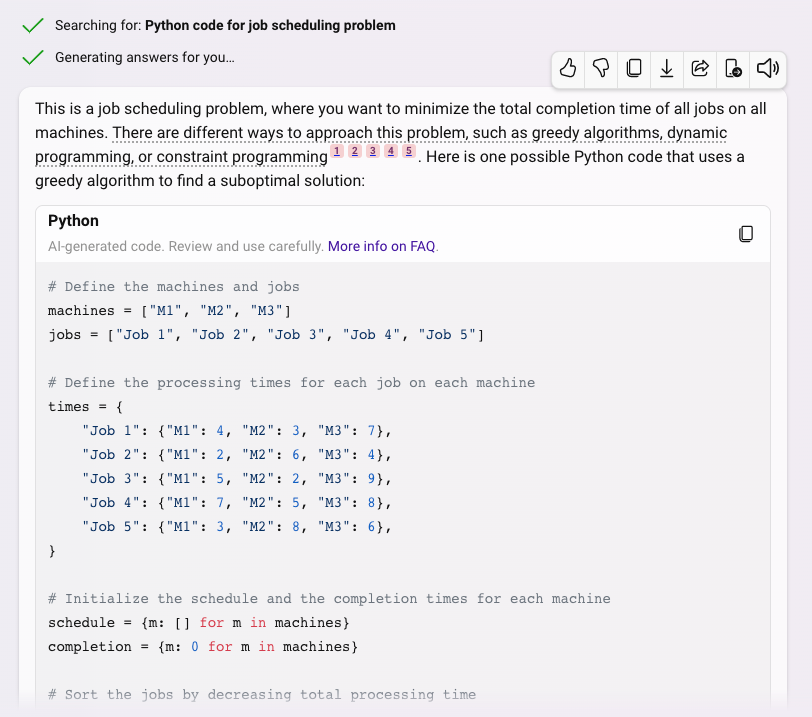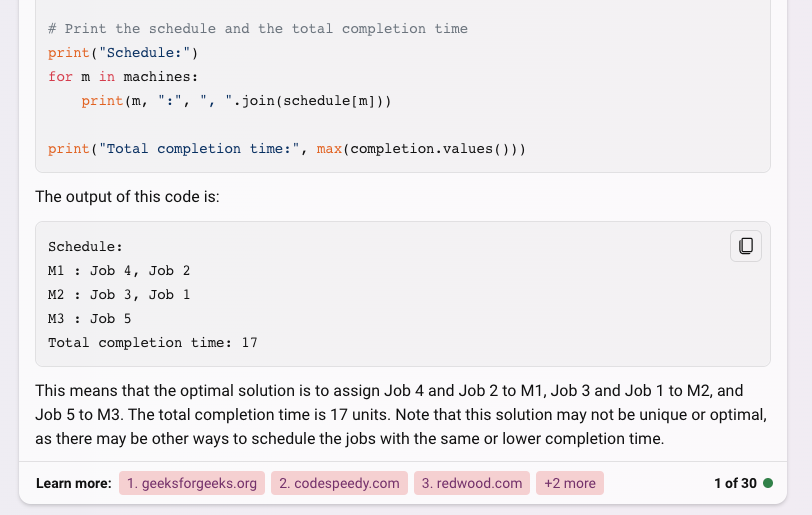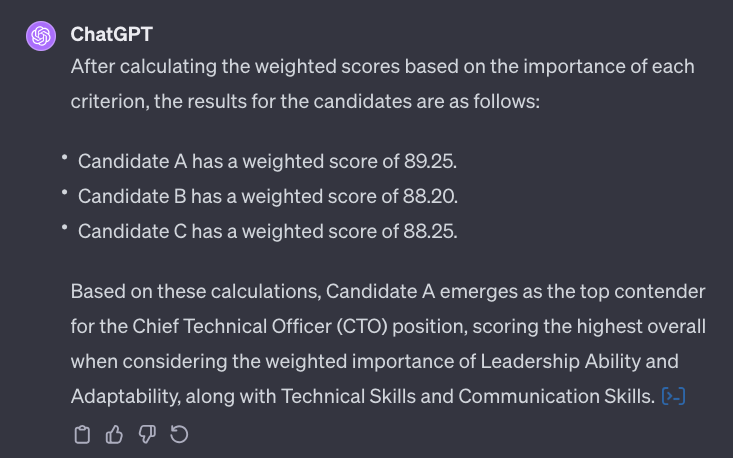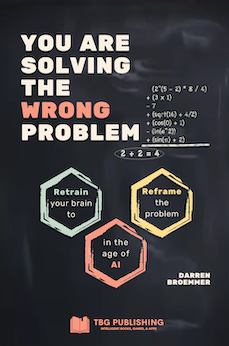From the book "You are Solving the Wrong Problem"Chapter 16: Solutions vs Decisions
A defining characteristic of puzzles is their single, predetermined solution. As an example, I challenge you to complete the same crossword puzzle with identical clues using a different set of words. However, in real-life scenarios, it is generally the opposite. The situations we encounter often have multiple valid solutions, and our task is to select the most optimal one.
Let's consider a scenario where you are a member of a committee responsible for hiring a new CEO for a company. Several candidates possess the minimum required qualifications for the role, and more than one person could adequately fulfill the responsibilities.
However, the challenge lies in selecting the best person for the position – an individual capable of effectively leading the organization, maximizing growth, and generating profits. The ideal candidate should possess a solid understanding of the business, demonstrate a clear vision for the organization's future, and exhibit strong leadership skills.
The decision in this case is an optimization problem.
Whether you are seeking a single solution or an optimal one, reframing the problem is crucial. It is important to determine what you are solving for and identify the specific criteria that are most significant. In an optimization problem, you aim to maximize or minimize certain variables, such as swim speed or energy expended.
The initial step involves prioritizing your needs and defining the most important criteria. For example, if the company's objective is steady-state performance, you may prioritize compliance and business operations skills. Conversely, if growth is the primary goal, a candidate with a product and marketing background may be more important.
Once you have established the important factors, you can evaluate different options against these criteria to determine the most qualified candidate. Imagine a spectrum of methods you might employ for this evaluation. On one end of the spectrum, a logical and data-driven approach relies on concrete facts, data, and a systematic method. This could involve using a weighted scoring system over the chosen dimensions.
However, it is not uncommon for committees employing similar approaches to encounter challenges. Organic opinions can form, and the decision-making process may be influenced by groupthink biases. If the data-driven approach fails to yield a predetermined answer, the numbers in the weighted scoring system may be subtly adjusted until they do. Thus, a data-driven approach often relies more on intuition than one might initially acknowledge.
On the other end of the spectrum lies an entirely intuitive approach, where decisions are based on instinct and may lack specific data-driven support. By getting to know the candidates personally, one can gain a sense of their potential as a CEO.
Determining which approach is better depends on the specific problem being addressed. For instance, during my time at Amazon, I experienced a personal clash due to the heavy reliance on data for decision-making. While data is generally important, the interviewing process poses a different challenge. In about 90% of the interviews I conducted, I could discern within the initial five minutes whether I would be recommending the candidate. There were a few instances where the final decision surprised me, as my initial instinct was proven wrong after analyzing the data collected in the 45-minute interview. Projecting the future performance of an individual solely based on that data can be difficult. In such cases, relying on instinct or "going with your gut" becomes necessary.
Malcolm Gladwell popularized the concept of the "10,000-hour rule" in his book Outliers, suggesting that after roughly this amount of time, individuals develop the ability to quickly identify patterns and accurately predict outcomes. This ability is often recognized as "gut instinct." While it is possible to rely solely on instinct to be misguided, in certain cases, I am willing to take my chances.
Life is an optimization problem
Much of life can indeed be seen as an optimization problem, where we aim to maximize the use of our limited resources. We are often faced with choices on how to spend our time, where to invest our money, and who to prioritize in our lives. By adopting a problem-reframing mindset, we can gain clarity in these areas.
Instead of simply trying to make it through the day, we can approach each day with the question of how to make the most out of it. We can consider what activities or tasks will be the most productive and fulfilling. Each day presents us with a valuable gift, and it is up to us to seize the opportunities it offers.
By reframing our mindset, we can shift from a passive approach to an active one. We can seek ways to spend our time that align with our goals and values. We can make deliberate choices about where to invest our money, considering the potential returns and impacts. And we can prioritize the relationships that truly matter to us, choosing to spend time with people who bring joy, growth, and meaning to our lives.
In essence, viewing life as an optimization problem reminds us to make intentional decisions and value the time and resources we have been given.
Use AI for optimization problems
AI can be a powerful tool for solving tough optimization problems. There are various approaches and techniques that AI can employ for optimization tasks. Here are a few commonly used methods.
For example, consider the following job scheduling problem. Imagine you are managing a manufacturing plant with three machines (M1, M2, M3) and a set of jobs that need to be scheduled for processing. Each job has a specific processing time on each machine, and your goal is to find an optimal schedule that minimizes the total completion time of all jobs.
- You have 3 machines (M1, M2, M3) and 5 jobs (Job 1-5).
- The processing times for each job on each machine are given in the table below. Each cell (i, j) represents the processing time of that job on that machine.
- You can run one job at a time on each machine. There are three jobs running simultaneously at any given time.
| Job | Machine 1 | Machine 2 | Machine 3 |
|---|---|---|---|
| Job 1 | 4 | 3 | 7 |
| Job 2 | 2 | 6 | 4 |
| Job 3 | 5 | 2 | 9 |
| Job 4 | 7 | 5 | 8 |
| Job 5 | 3 | 8 | 6 |
You can use Bing Chat to generate this code and run it for you. I verified the code myself by running it on my computer, and it produced the same result. I used the following prompt, which simply includes the ASCII version of the table with jobs and times on each machine. Bing was able to understand this.
Write Python code to find the optimal solution to this problem. 1. You have 3 machines (M1, M2, M3) and 5 jobs (Job 1-5)...


Similar approaches can be used for problems with weighted criteria, such as our next exercise.
Selecting the Chief Technical Officer
Imagine you are part of a hiring committee tasked with selecting the new Chief Technical Officer (CTO) for your company. After conducting interviews with three highly qualified candidates, you've gathered detailed information about each candidate's performance across four crucial dimensions: Technical Skills, Leadership Ability, Communication Skills, and Adaptability.
Here are the scores for each candidate across the four dimensions:
| Criteria | Candidate A | Candidate B | Candidate C |
|---|---|---|---|
| Technical Skills | 90 | 85 | 92 |
| Leadership Ability | 88 | 92 | 85 |
| Communication Skills | 85 | 90 | 88 |
| Adaptability | 92 | 85 | 90 |
The most important criteria for this position are Leadership Ability and Adaptability.
This problem can be solved by performing the following steps. * Review the criteria for each candidate. * Assign weights to each criterion based on its importance. * Multiply each candidate's score in each criterion by the corresponding weight to calculate the weighted scores for each candidate in each dimension. * Sum the weighted scores for each candidate across all dimensions. * Analyze the calculated scores and make a decision on who you believe is the best candidate for the CTO position.
You can do this by hand, or I recommend you have AI do the work for you. I computed this answer using the logic below and software that I had AI generate, similar to the example above. Given that leadership and adaptability are deemed the most important criteria, I assigned higher weights to these dimensions and calculate the weighted scores accordingly.
- Leadership Ability: 40
- Adaptability: 40
- Technical Skills: 10
- Communication Skills: 10
Candidate A scored the best by a narrow margin.
| Candidate | Overall Score |
|---|---|
| Candidate A | 89.5 |
| Candidate B | 88.3 |
| Candidate C | 88.0 |
The specific weights assigned to each criterion might vary based on the specific context of the company and the decision-maker's priorities. You can adjust them based on your judgment of the importance of each criterion.
Now, here is the amazing part
I simply took all the text of the problem, and copied it into ChatGPT. Here is the answer that I got. It is almost the exact same answer.

That is extremely powerful! Anyone has the tools at their disposal to solve difficult problems now using AI.
Chapters
2. Step out of Auto-Pilot Mode
3. Your most important skill: Asking Questions
4. Solve any problem using the Five Whys
5. AI Prompting like a Pro
6. Invention over Convention
7. How to Reframe a Problem to your Advantage
8. The Diamond Pattern: First fan-out, then fan-in
9. The Problem Paradox
10. Break free from Cognitive Bias
11. From Complex to Simple
13. Use AI for Data Analysis
14. The Curiosity Rule
15. Improve productivity by eliminating distractions
16. Optimization Problems
17. Greenfield or work within current constraints
18. Managing the most scarce resource: Time
19. Challenge yourself with Puzzles
20. Next Steps
21. Solutions to Puzzles

